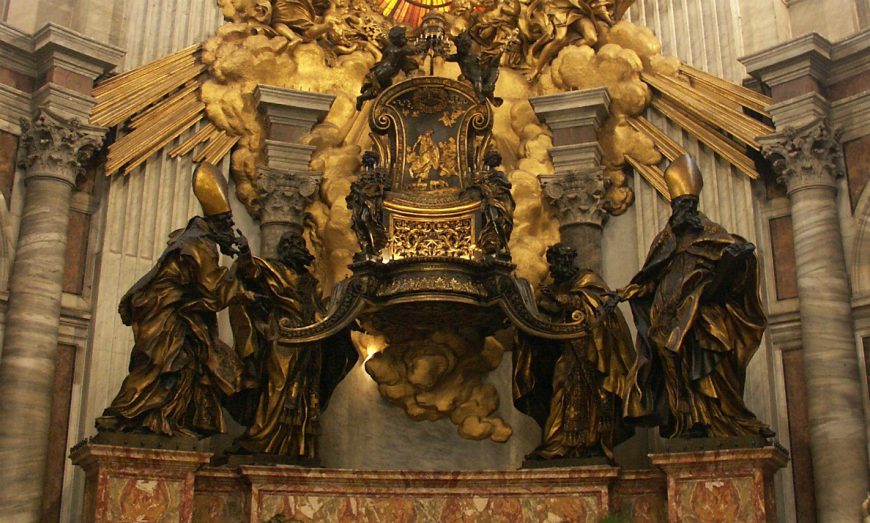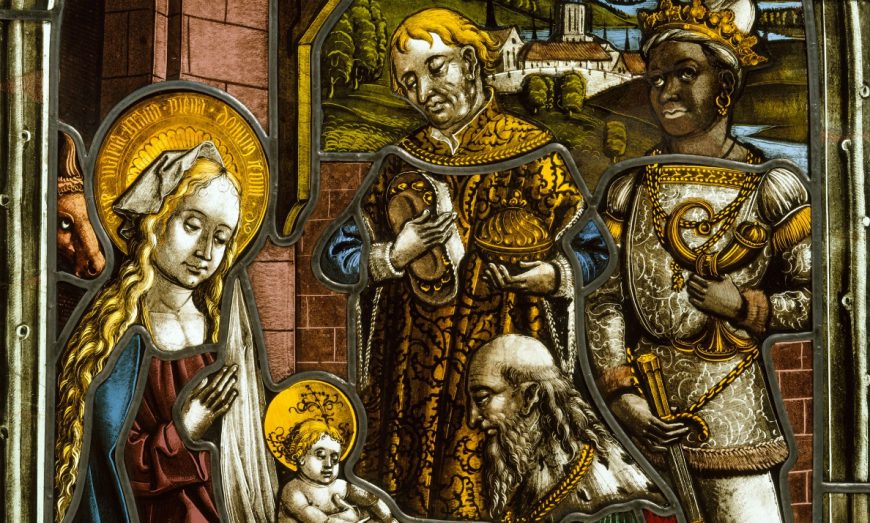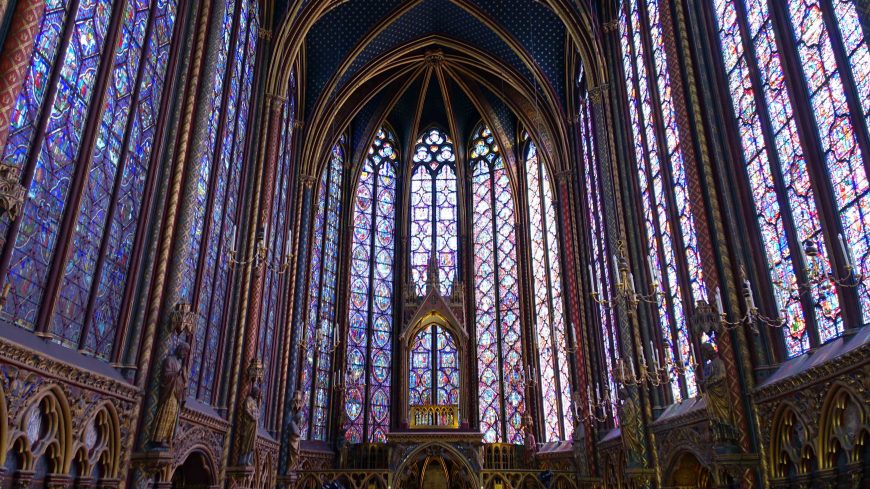Four stained glass windows by Sir Edward Burne-Jones, Ascension (1885), Nativity (1887–88), Crucifixion (1887–88), and Last Judgment (1897) (produced by Morris and Co. for Birmingham Cathedral) A conversation with Dr. Steven Zucker and Dr. Beth Harris.
Sir Edward Burne-Jones, stained glass windows at Birmingham Cathedral
[0:00] [music]
Dr. Steven Zucker: [0:04] We’re in Birmingham Cathedral, this 18th-century church, but in it is a spectacular example of late 19th-century stained glass designed by Edward Burne-Jones.
Dr. Beth Harris: [0:18] Burne-Jones designed stained glass windows for much of his career and enjoyed designing specifically for the medium of stained glass. Here, we’re in a part of the church that was enlarged in the 19th century.
[0:33] Burne-Jones was commissioned to design at first a window of the subject of the Ascension, where we have below the apostles and Mary, and above, Christ and angels in heaven. We’re struck by the amazing color that the firm of Morris and Company was able to achieve with this glass.
Dr. Zucker: [0:55] Vivid ruby reds, these beautiful, jewel-like blues, and then these more subtle pinks and yellows and greens. It is luminous in a way that a painting never could be because this is not light reflecting on a surface. This is light moving through the surface of the color itself.
Dr. Harris: [1:14] Burne-Jones was so pleased with the Ascension that he designed two more, one on either side. On the left, we have the Nativity and the Annunciation to the Shepherds, and on the right a scene of the Crucifixion.
Dr. Zucker: [1:26] This was an especially important commission for the artist because he was baptized in this church and had grown up just a few blocks away. This commission must have felt very personal.
Dr. Harris: [1:37] I think it’s critical to remember that we’re here in the northern industrial city of Birmingham, an important industrial center with factories, with pollution, with all the inequities that came with the beginnings of the Industrial Revolution. It’s important to see this as the context for these powerful and spiritual images.
Dr. Zucker: [2:02] These stained glass windows are a refuge. They are an attempt to retrieve moral and spiritual meaning, even in the context of this newly-industrialized culture.
Dr. Harris: [2:13] Christ stands in the center. The angels hold their hands in positions of prayer. Christ, with his left hand, makes a gesture of blessing, but with his right hand gestures down toward the earthly, toward his disciples.
[2:28] The figures in heaven stand primarily in frontal positions. They’re symmetrical. There’s a sense of transcendence, but the figures below clasp their hands, look up in awe of this moment when Christ rises, ascends to heaven. The part that strikes me as so innovative in terms of the stained glass is the angel who wears subtle variations of color that I would never associate with stained glass.
Dr. Zucker: [2:58] It’s almost as if we’re looking at the most delicate watercolor.
Dr. Harris: [3:02] If we look to the scene of the Nativity, which occupies the bottom part of the window, and at the top, the Annunciation to the Shepherds, the focus of this composition is on this sleeping child, the Christ Child, swaddled in white, with a cruciform halo, but sleeping very much the way that a little baby sleeps.
[3:25] Beside him, we see Mary, who leans over him protectively, Saint Joseph on the right, and angels who look down at him in awe.
Dr. Zucker: [3:34] But the child is on just a little spit of land that is surrounded by a stream that curves around him. We can look through the surface of the water and see the pebbles at the base of the stream. We can make out the geology of the rocks on either side. There is this tremendous interest in the natural world.
Dr. Harris: [3:53] We do have this sense of the passage of time, of the water in the stream that’s worn away the rocks. Above, we see three shepherds, their flock of sheep, and angels wearing the most vibrant pinks, oranges, and reds.
Dr. Zucker: [4:11] The angels are attenuated. They are especially long, creating a sense of elegance and of the otherworldly.
Dr. Harris: [4:18] Then you have in the center this forest of trees without leaves, but it’s these swirling forms that activate the divine.
Dr. Zucker: [4:27] The sweetness and sentimentality of the Nativity is sharply contrasted with the brutality of the window on the right, the Crucifixion.
Dr. Harris: [4:36] Here, Christ is much larger. His arms span the width of the window. His body tilts forward and downward toward us so that we can see his face. The figures below, the lances, the flags, this kind of chaos that’s taking place around the central image of Christ on the cross.
Dr. Zucker: [4:58] Because the two side windows are slightly curved, Christ’s hands come towards us slightly. Even in this moment of grief, even in this moment of torture, there is this sense that he is embracing the congregation of this church.
Dr. Harris: [5:12] My eye is drawn to Mary as she clasps her hands and looks up toward her son on the cross. But right next to her is another figure, perhaps a Roman soldier, who looks directly out at us, almost in a way that feels accusing, as though he’s saying, “It is humankind who has done this, who is responsible for this.”
Dr. Zucker: [5:35] At the foot of the cross, we have a kneeling figure weeping. This is Mary Magdalene. To the right of the cross, we see St. John the Evangelist, and beyond that forest of stakes, we can see the distant city of Jerusalem against this brilliant sapphire sky.
Dr. Harris: [5:52] Now, there’s one more Burne-Jones window in another part of the church that was added in the late 19th century, and that’s a scene of the Last Judgment.
Dr. Zucker: [6:00] Light is pouring through it because it’s the afternoon.
Dr. Harris: [6:03] Christ, enthroned in heaven, surrounded by angels, and below him, St. Michael, who blows a trumpet to awaken the dead from their graves. Below, a scene of a city that looks like it’s disassembling before our eyes as the masses of humanity try to make sense of this moment, of the end of the world, the end of time.
Dr. Zucker: [6:27] These are souls that have just been awakened and have just crawled out of the tombs that they now crowd upon. As we look at the window, the sun comes through the opening of the horn held by St. Michael, in such sharp contrast to the dark handling of the city of man below.
Dr. Harris: [6:44] I’m reminded of Burne-Jones’ desire to effect social change. His good friend, William Morris, was politically active, but for Burne-Jones, that kind of political activism, that desire to change, to reform the world, was something that he dedicated his life to through the creation of beauty.
[7:08] [music]
| Title | Ascension | Crucifixion | Last Judgment | Nativity |
| Artist(s) | Design by Edward Coley Burne-Jones, produced by Morris and Co. (founded by William Morris) | Design by Edward Coley Burne-Jones, produced by Morris and Co. (founded by William Morris) | Design by Edward Coley Burne-Jones, produced by Morris and Co. (founded by William Morris) | Design by Edward Coley Burne-Jones, produced by Morris and Co. (founded by William Morris) |
| Dates | 1885 | 1887–88 | 1897 | 1887–88 |
| Places | Europe / Western Europe / England | Europe / Western Europe / England | Europe / Western Europe / England | Europe / Western Europe / England |
| Period, Culture, Style | Victorian / Mid-Victorian / Pre-Raphaelitism | Victorian / Mid-Victorian / Pre-Raphaelitism | Victorian / Mid-Victorian / Pre-Raphaelitism | Victorian / Mid-Victorian / Pre-Raphaelitism |
| Artwork Type | Stained glass | Stained glass | Stained glass | Stained glass |
| Material | Glass | Glass | Glass | Glass |
| Technique |
Edward Burne-Jones, Victorian artist-dreamer (free pdf from The Metropolitan Museum of Art)
Divine beauty at Birmingham Cathedral
Caroline Arscott, William Morris and Edward Burne-Jones : interlacings (Paul Mellon Centre, 2008)
Jim Cheshire, Stained glass and the Victorian gothic revival (Manchester University Press, 2005)
Martin Harrison, Victorian Stained Glass (Barrie & Jenkins, 1980)
Andrea Wolk Rager, The Radical Vision of Edward Burne-Jones (Paul Mellon Centre, 2022)
Loading Flickr images...





